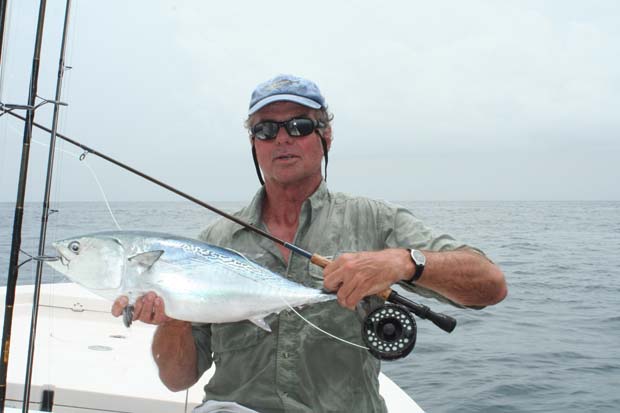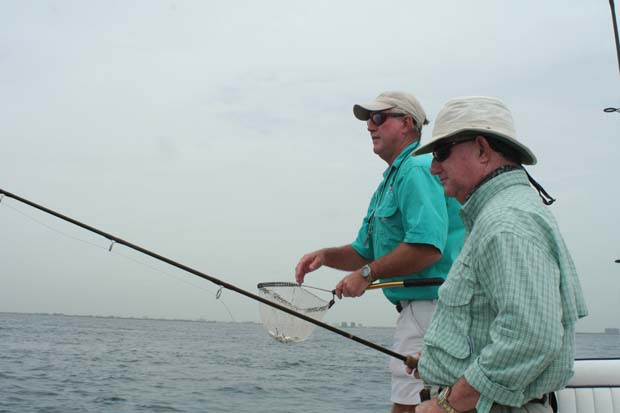By Steve Kantner
[dropcap]T[/dropcap]he possibility of using flies in deep, offshore waters continues to intrigue many long-rod addicts. But one drawback they face is the difficulty inherent in attracting fish to the boat—meaning within reach of a fly. Now the use of live chum has allowed everyone to get in on the act. While the technique itself is fairly-straightforward, anglers should be aware of several requirements:

Author Steve Kantner gets his chumming reward, landing a nice false albacore/albie. It resembles the Atlantic bonito, skipjack tuna and is actually a species of mackerel.
The first involves the use of flies that closely match what they’re using for chum. Of several factors worth considering, size is foremost. So don’t waste time casting a five-inch Deceiver to fish that are feeding on glass minnows or spearing.
Anglers should also maintain a realistic silhouette that imitates the shape of their chosen chum. Rigging with slim, sparsely-dressed patterns in order to imitate Spanish sardines, or bulkier flies to match pilchards and bunker says it all. Include the proper amount of flash and you’ve got three out of four—something that can be determined through trial and error or by studying established patterns.
Movement (call it action) is the final frontier. A prime example takes place whenever you strip a fly through a school of feeding bonito and discover, to your disbelief, that they totally ignore it. Depending on the situation, either allowing it to dead-drift or stripping it slower or faster often elicits an immediate strike.
The general rule here is to watch how live chum behaves in the water. If it skitters or runs, make a fast-strip retrieve. It goes without saying that any dead baits gleaned from the bottom of the well are best imitated with dead-drifted flies.
Now, consider the following: For starters, try maximizing the amount of chum that you can carry by remembering that smaller is better. The best way to accomplish this, if you have two wells, is to use a cast net to fill one with tiny baits such as baby pilchards or immature Spanish sardines, before loading the second with larger baits. Full-sized thread herrings or cigar minnows that you catch on a sabiki rig need more space and oxygen, whereas tiny netted “chummies” don’t have stringent requirements. Keep in mind that it’s their number and not their size that attracts game fish.
Don’t hesitate to change flies whenever you switch from one type of baitfish to another. For example, if you change from pilchards to glass minnows, it’s time to re-rig.
Then, toss your “chummies” far enough from the boat to get the game fish’s attention before the baits have a chance to swim back to safety. One of the best ways to accomplish this is by scooping-up half-a-dozen baits in a bait net and literally “spanking” them to where the angler intends to cast, which is usually in the wake of a drifting boat. A smack from the guide’s hand tends to stun the baitfish and buys the angler additional time to work out his line, which the angler should extend only enough of to place his fly in the path of oncoming fish.
How far the guide tosses the chum makes a major difference, but it shouldn’t replace accuracy. In other words, make sure the chum stays within range of the caster. When the fish first come up, you’ll be surprised to see how many baits make it to the safety of floating weeds or debris or in some cases, back to the boat.
Incidentally, that’s the time to scoop them up with the bait net and toss them out again.
Too much chum, not surprisingly, can be detrimental. Nevertheless, it’s more common for false albacore, rainbow runners, and tuna to lose interest than for species like mahi mahi that tend to stay around the boat, to become overfed.
A handful of live “chummies” is the coin of this commerce. Still, it’s a good idea to include individuals that have died in the well, after enticing predators initially with the genuine article. But keep this in mind: A few livies go further than a net full of dead ones
If there are negative sides to this developing practice, it’s in the number of baitfish that are required to support it, along with one caveat:
Fish that rise to chum on a regular basis seem to lose their interest in mainstream approaches (say, simply casting or “dredging”). Back in the day, most anglers never used it—we didn’t have to.




